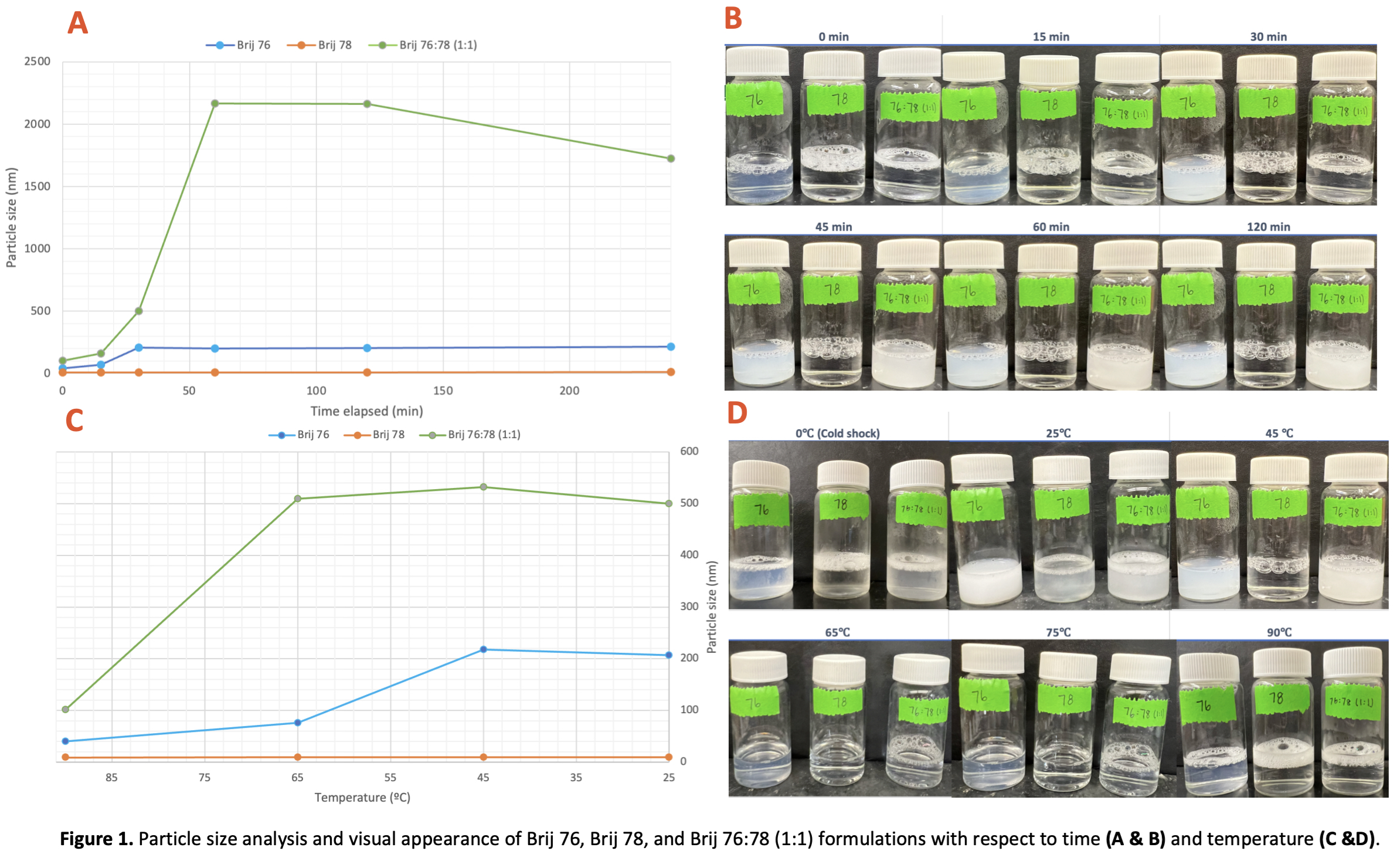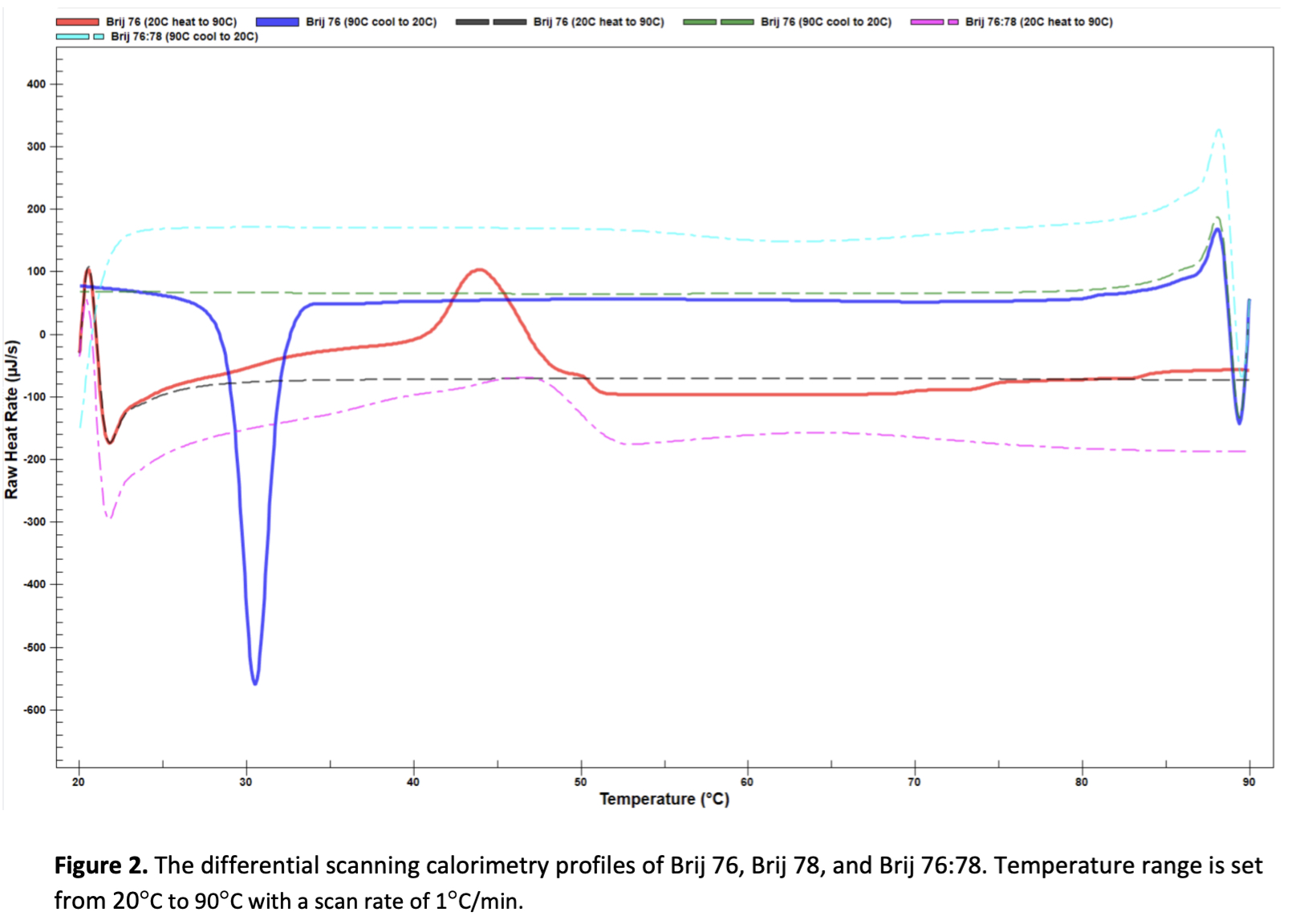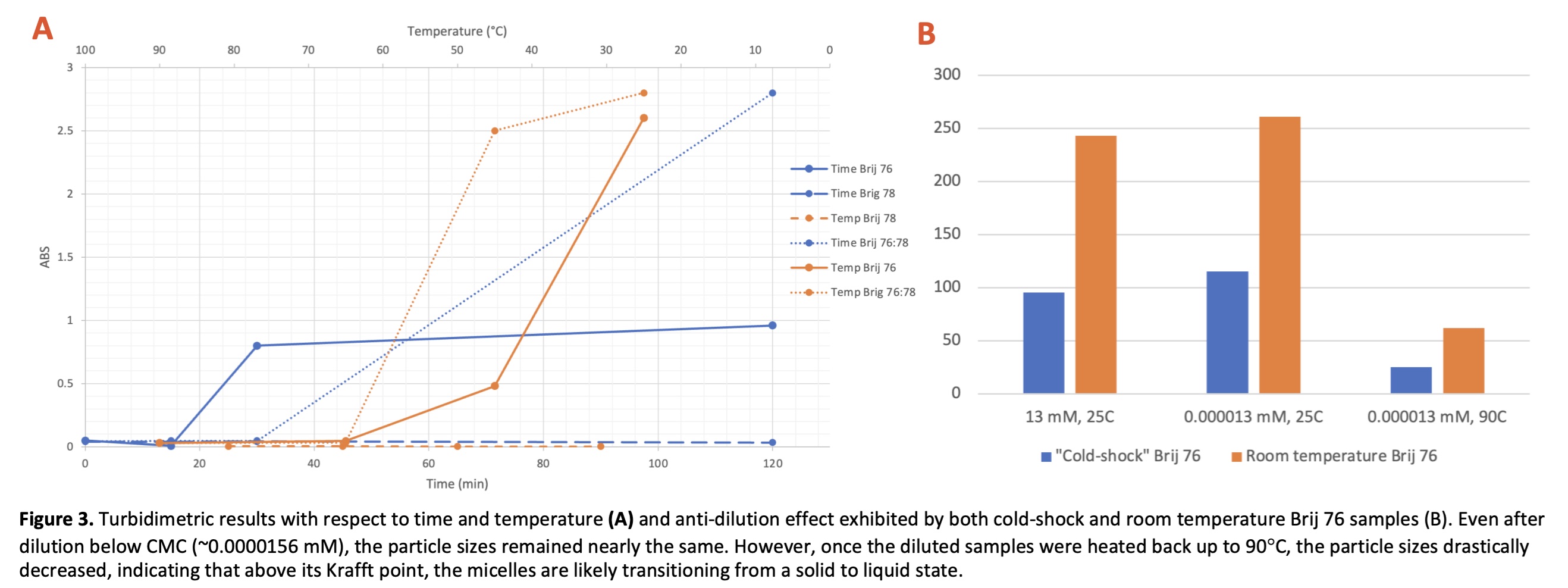Formulation and Delivery - Chemical
Category: Poster Abstract
(M1530-02-13) Preparation of Nanoparticles Based on Krafft Point of Nonionic Polyoxyethylated Amphiphiles
Monday, October 23, 2023
3:30 PM - 4:30 PM ET
- JL
Jessica Li, BA
University of the Pacific
Dublin, California, United States - JL
Jessica Li, BA
University of the Pacific
Dublin, California, United States - LG
Landy Gu
University of the Pacific
Stockton, California, United States - LX
Liang Xue, Ph.D.
University of the Pacific
Stockton, California, United States - BJ
Bhaskara Jasti, Ph.D. (he/him/his)
University of the Pacific
Stockton, California, United States .jpg)
Xiaoling Li, Ph.D. (he/him/his)
Professor
University of the Pacific
Stockton, California, United States
Presenting Author(s)
Main Author(s)
Co-Author(s)
Purpose: Poor aqueous solubility of drugs is a major concern in drug development and delivery (1). Various solubility-enhancing technologies have been developed to address this issue. Micellar solubilization is one of various solubility enhancing technologies available; however, micelles are prone to premature dissociation upon dilution below a specific critical micelle concentration (CMC). Therefore, the purpose of this project is to develop a simple and scalable method to prepare micellar-sized nanoparticles using amphiphilic molecules.
Methods: Nanoparticles were prepared by forming a micelle solution at a temperature above the Krafft point of the amphiphilic molecules, and then gradually cooled to room temperature or chilled to 0-4°C to form micellar solid nanoparticles. Specifically, Brij 76, Brij 78, and Brij 76:78 (1:1), were dissolved in distilled water with a concentration of 13 mM at temperatures higher than their respective Krafft points. While cooling to 25°C, images were captured at regular intervals to document samples’ appearance and temperature of samples were recorded. Separate samples were prepared using the same method, but immediately placed in ice for 30 minutes before characterization. Particle sizes of micelle solutions at higher temperatures and solid nanoparticle at lower temperatures were determined by using Zetasizer 3000HS (Malvern Instruments Ltd, UK). Stability of nanoparticles in diluted solution was studied using size analysis. The turbidimetric analysis was performed at 25, 45, 65, 75, and 90°C using a UV-1601 spectrophotometer (Shimadzu, Japan).
Results: Sizes of micelles for Brij 76, Brij 78, and Brij 76:78 (1:1) at elevated temperature samples (90°C) were 39.84 ± 9.07 nm, 9.24 ± 0.372 nm, and 101.27 ± 22.7 nm, respectively. The sizes of Brij 78 remained at 9.93 ± 0.63 nm when cooling, while the sizes of Brij 76 and Brij 76:78 (1:1) gradually increased to 205.6 ± 6.3 nm and 2017 ± 281.26 nm over two hours, respectively, likely due to aggregation. When Brij 76 samples were cooled on ice immediately, the particle sizes remained at 69.73 ± 1.53 nm overnight. Samples Brij 76 and Brij 76:78 (1:1) became opaque when the temperature reached around 50°C (Figure 1D), while the particle size began to slightly increase. Upon dilution to a concentration below CMC, the sizes of “cold-shock” and room temperature samples of Brij 76 at 25°C remained near the same sizes as their respective undiluted solutions, at 95.57 ± 1.74 nm and 243 ± 24.8 nm, respectively. Once both samples were heated back above Krafft point, the “cold-shock” and room temperature Brij 76 samples had particle sizes of 24.8 ± 8.1 nm and 61.61 ± 4.2 nm, respectively. DSC analysis showed a phase change in the Brij 76 sample, reflected by the sharp exothermic peak around 30°C and reproducible endothermic peak around 45°C when the solution was heated to 90°C (Figure 2).
Conclusion: Based on visual observation, turbidity, particle size and DSC analysis, a Brij 76 only micelle system can be used for synthesizing solid micelles, with or without employing the “cold-shock” method, for an enhanced anti-dilution effect in comparison with conventional micelles. More importantly, this method is a simple and scalable process for preparing nanoparticles based on Krafft point of polyethylene oxide-based amphiphilic molecules using a thermal-cooling mechanism. The nanoparticles at micellar size remain stable even in a diluted solution. Therefore, these “solid micelle” nanoparticles have potential to be used as drug carriers in pharmaceutical applications, such as solubility enhancement and targeting delivery.
References: 1. Gao, X., Jasti, B. R., Huang, M., Wang, X., Mahalingam, R., & Li, X. (2020). Design and preparation of nanostructures based on Krafft point of nonionic amphiphiles for delivery of poorly water-soluble compounds. International journal of pharmaceutics, 588, 119789. https://doi.org/10.1016/j.ijpharm.2020.119789
 Figure 1. Particle size analysis and visual appearance of Brij 76, Brij 78, and Brij 76:78 (1:1) formulations with respect to time (A & B) and temperature (C &D).
Figure 1. Particle size analysis and visual appearance of Brij 76, Brij 78, and Brij 76:78 (1:1) formulations with respect to time (A & B) and temperature (C &D).  Figure 2. The differential scanning calorimetry profiles of Brij 76, Brij 78, and Brij 76:78. Temperature range is set from 20°C to 90°C with a scan rate of 1°C/min.
Figure 2. The differential scanning calorimetry profiles of Brij 76, Brij 78, and Brij 76:78. Temperature range is set from 20°C to 90°C with a scan rate of 1°C/min.  Figure 3. Turbidimetric results with respect to time and temperature (A) and anti-dilution effect exhibited by both cold-shock and room temperature Brij 76 samples (B). Even after dilution below CMC (~0.0000156 mM), the particle sizes remained nearly the same. However, once the diluted samples were heated back up to 90°C, the particle sizes drastically decreased, indicating that above its Krafft point, the micelles are likely transitioning from a solid to liquid state.
Figure 3. Turbidimetric results with respect to time and temperature (A) and anti-dilution effect exhibited by both cold-shock and room temperature Brij 76 samples (B). Even after dilution below CMC (~0.0000156 mM), the particle sizes remained nearly the same. However, once the diluted samples were heated back up to 90°C, the particle sizes drastically decreased, indicating that above its Krafft point, the micelles are likely transitioning from a solid to liquid state.